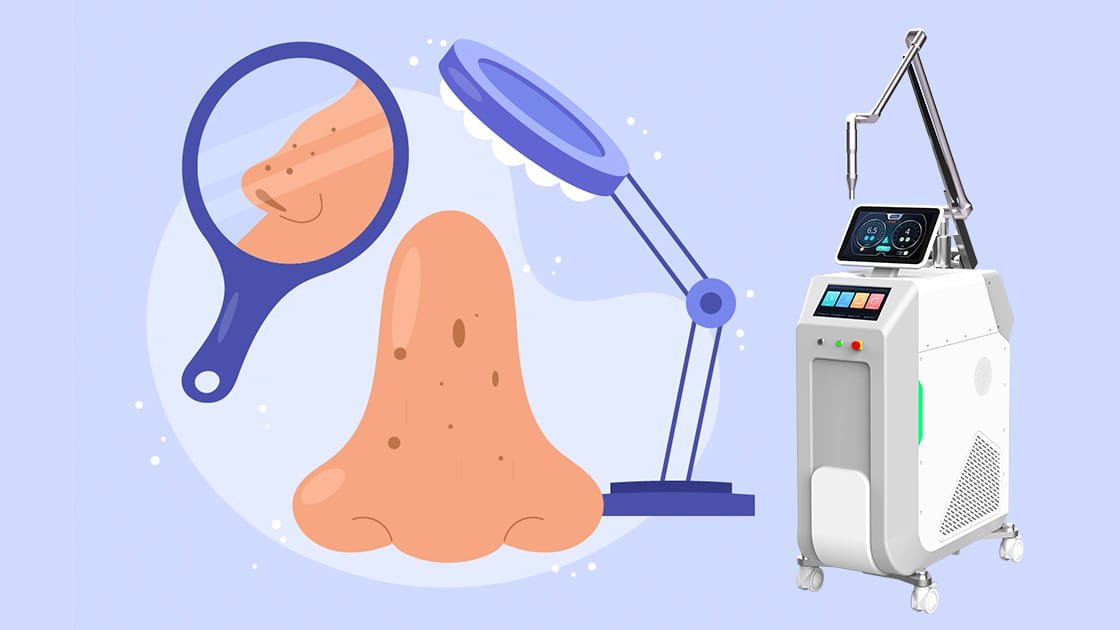Nose pores can be a major source of frustration, especially when they appear enlarged and make the skin look rough. But why are pores more prominent in areas like the nose, and can laser therapy actually reduce their size? The answer is yes—laser therapy for shrinking pores has proven to be an effective solution.
Why Nose Pores Appear Enlarged
Enlarged nose pores are primarily caused by genetics, but several factors contribute to their noticeable size. Pores are small openings on the surface of the skin that release sebum, a natural oil produced to keep the skin moisturized. On the nose, these pores tend to be more prominent due to the higher concentration of sebaceous glands.
Over time, excessive oil production can mix with dead skin cells, clogging pores and stretching them out. Environmental factors, such as sun damage and pollution, can also weaken the skin’s elasticity, making pores appear larger. As the skin ages, it loses collagen and elasticity, which can further exacerbate the visibility of pores, especially around the nose area.
How Laser Therapy Works for Pore Reduction
Laser therapy offers a promising solution for shrinking pores. Unlike topical treatments, which only address the surface, laser therapy penetrates deeper layers of the skin to stimulate collagen production and tighten the skin. Collagen, a protein that gives skin its firmness, is crucial in minimizing the appearance of pores.
Laser treatments, such as fractional or non-ablative lasers, target the skin’s deeper layers without damaging the surface. This triggers the body’s natural healing process, resulting in smoother, tighter skin over time. By boosting collagen levels, laser therapy helps to strengthen the skin around the pores, reducing their size and visibility.
Additionally, lasers can help reduce excess oil production, which is a key contributor to enlarged pores. By regulating oil and improving the overall texture of the skin, laser therapy creates a more refined appearance.
Why Minimizing Pore Size Is Important
Minimizing pore size goes beyond aesthetics. Smaller pores help maintain clearer skin because they’re less likely to get clogged with oil, dirt, and dead skin cells, which can lead to acne and blackheads. By shrinking the pores, laser therapy can help reduce breakouts and improve the overall health of the skin.
Smaller pores also give the skin a smoother, more even texture, which enhances the effectiveness of skincare products and makes makeup application easier. Minimizing pores is not only about reducing blemishes but also achieving a more youthful, radiant complexion. As collagen production increases, the skin looks firmer and fresher, offering long-term anti-aging benefits.
What to Expect During Laser Treatment
Laser therapy for pore reduction is a relatively quick and painless procedure. Most treatments take about 30 minutes, depending on the area being treated. During the session, a dermatologist uses a laser device to direct light energy to the deeper layers of the skin. Patients may feel a mild tingling sensation, but discomfort is minimal.
After treatment, the skin may appear slightly red or swollen, similar to a mild sunburn, but this typically subsides within a few hours. Since laser therapy is non-invasive, there is little to no downtime, allowing patients to resume normal activities immediately. For the best results, multiple sessions may be recommended over several weeks.
While some improvement may be noticeable after the first session, the full effects of laser therapy often become visible after several treatments as collagen production increases and the skin continues to heal.
Conclusion
Laser therapy offers a powerful, non-invasive solution for shrinking enlarged nose pores. By stimulating collagen production and improving skin texture, this treatment not only reduces pore size but also promotes overall skin health. With minimal downtime and lasting benefits, laser therapy is an excellent option for anyone looking to achieve smoother, clearer skin.








